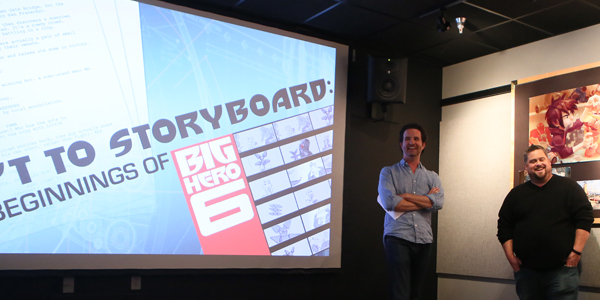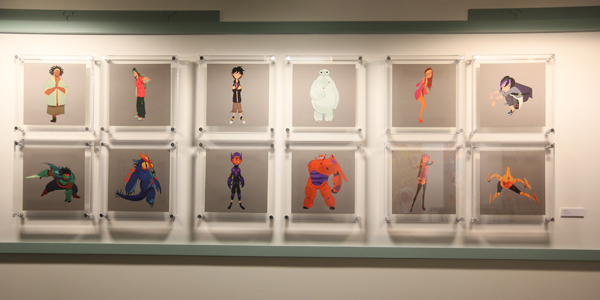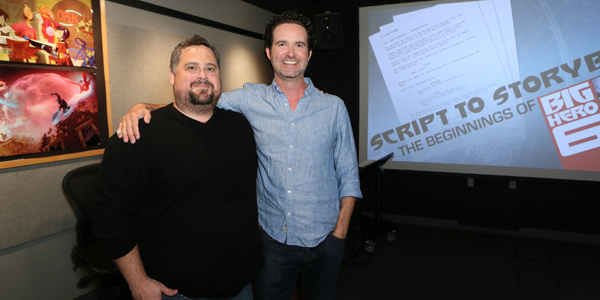It takes more than writing one simple draft to create the perfect script. There are times where screenwriters take years to formulate a solid plot for the film they’re working on. It takes a lot of time, effort, feedback and every once in awhile some debates or arguments in order to shove the bad ideas out and make that story perfect.
When you’re working for Disney Animation Studios, like writer Robert Baird and the Head of Story Paul Briggs, there’s an automatic a level of dedication and patience that’s required of the employees in order to piece together the right story. After all, this is Disney and the last thing anyone would want to see is a sub-par script. The story must contain all the key ingredients that makes each Disney animated film so magical and moving for audience members around the world. So once they’re given the general premise, they immediately get to work on the outline for the script.
The journalists shuffled into the room and listened to Paul Briggs and Robert Baird as they described the effort it took to formulate ‘Big Hero 6.’ “A lot of people don’t realize that the story takes 4-5 years to make,” said Briggs. “A huge chunk of that process is devoted to story. It’s an extremely difficult process.”
When you’re working at Disney Animation Studios, there is a specific aspect of the script process that many love to use, and that’s creating storyboards. For those who aren’t familiar with the term, storyboards are a number of drawings that illustrate scenes in a script as a visual display for the directors, producers and everyone else to see. It makes the “first screenings” at Disney Animation Studios that much more fun to watch. It’s crucial for those on the creative staff to sit in on the screenings with their “story trust,” that way they can receive notes on what’s good and bad about the story before they lock in the script and send it off to the animators.
There’s an added amount of pressure set into making the perfect script, especially when there’s so many people who are giving their two creative cents into the process. “I don’t know if you know the TV writing process, but it’s a lot like writing for a TV show,” continued Briggs. “All those people are in a room sitting around a table for months and months. We’re just talking and building a story and everybody’s just trying to make the best movie possible. So this movie started with Don Hall pitching to John Lasseter this idea of this Marvel property about a boy and this robot. It’s a mashup of Marvel and Disney, so super exciting, but they had to kernel the idea with this concept. The story department, us, come in here and say okay, we’ve got this concept. Let’s start building the story.”
The amount of time it takes to build a story can vary with each project, but the writing sessions can lean towards the stressful side. There’s so many pieces that have to fit just right into the story. Not only are they dealing with a pre-existing Marvel property, but the studio is actively choosing not to move along with sticking close to the source material. The writers had a lot on their plate since they essentially developed the story almost completely from scratch.
Once the writers were presented with such a vast amount of creative space in which to develop the story, differing opinions began to clash. “As we’re talking, we’re coming up with ideas and pinning them up to those boards, and a story starts to take shape,” explained Baird. “What you don’t see in this picture is how it smells in that room. We’re in there all day for weeks and weeks, but also everybody seems so calm. We’re yelling at each other, red in the face. People are so passionate about, especially in the early stages of the movie, because everybody is sort of has a different take on what the movie could be about, and you’re screaming at each other. Then it’s 12 and you go across the way to the ABC commissary, you talk, you laugh and you come back in here and you start yelling again. That could go on for months and months.”
The arguments don’t stem from whether or not they believe the writer in question is right. It’s each person’s job in that room to ensure that ‘Big Hero 6’ will eventually transform into the fantastic story everyone wants it to be. They don’t have all the time in the world to put it together. They have to answer to John Lasseter, the head of the animation studio, within certain intervals. That adds a bit more stress onto the lives of every person in that writer’s room. “You have to pitch to John (Lasseter), and nothing motivates you better than that fear,” said Baird. “You’re in there, you’re talking and by the end of the week we have to do the whole song and dance for John. Suddenly everything is starting to come together and that’s sometimes when all of the ideas start to work.”
“And so we’ve been in this room for months, talking and building this story. We’ll pitch it to John and then we’ll turn it into an outline and pitch to John. But at certain points in time you take that 30 page outline and turn it into the screenplay.” Baird continues on to speak about the tangible excitement that fills the air once everything begins falling into place with the story. “Now we’re getting into the detail and we start to give the characters their personalities and their voices. We’re trying to find those characters and trying to find out what’s funny about them and what’s heartbreaking about them. We also make discoveries like wow, the story on the board makes total sense. You go and you write your script and it’s now 130 page script and it’s supposed to be 85 pages. So you’re cutting things out and you’re starting to figure out what you actually need in the story.”
While Robert Baird and the rest of the writer’s room is busy pulling out their hair over completing the outline quickly for John Lasseter, the Head of Story is drawing inspiration from a different kind of environment. “As they’re locked away in their little writing dungeon, I have my silver pass, I go down to Disneyland and I’m on roller coasters,” said Briggs. “I’ll FaceTime with Rob, I’ll be eating a turkey leg and saying, ‘Oh, how’s it going?'”
They eventually conjure up in the writer’s room and solidify what they have pieced together for the plot. The writers have a few different screenings, ones where they showcase the story thus far in storyboard mode. The first couple screenings never go very well, but thanks to the feedback everyone is able to expand and tweak the story to their liking. By the end of it, Disney Animation Studios had what they wanted for ‘Big Hero 6.’
‘Big Hero 6’ is out in theaters everywhere on November 7, 2014. Feel free to read the previous posts on ShockYa.com’s early press day, between the production design and our chat with the filmmakers.



